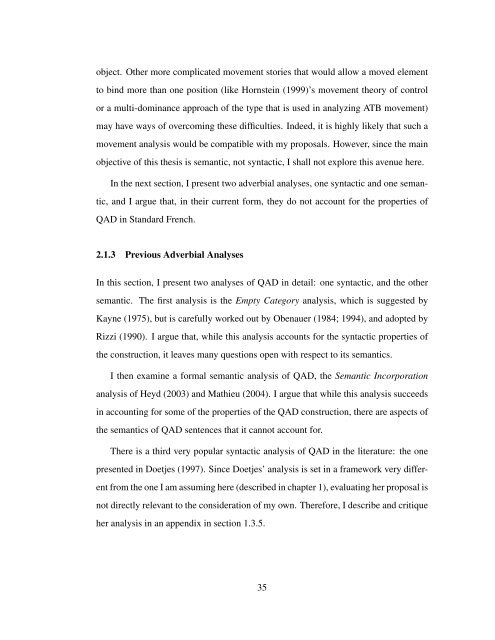Formal Approaches to Semantic Microvariation: Adverbial ...
Formal Approaches to Semantic Microvariation: Adverbial ...
Formal Approaches to Semantic Microvariation: Adverbial ...
You also want an ePaper? Increase the reach of your titles
YUMPU automatically turns print PDFs into web optimized ePapers that Google loves.
object. Other more complicated movement s<strong>to</strong>ries that would allow a moved element<br />
<strong>to</strong> bind more than one position (like Hornstein (1999)’s movement theory of control<br />
or a multi-dominance approach of the type that is used in analyzing ATB movement)<br />
may have ways of overcoming these difficulties. Indeed, it is highly likely that such a<br />
movement analysis would be compatible with my proposals. However, since the main<br />
objective of this thesis is semantic, not syntactic, I shall not explore this avenue here.<br />
In the next section, I present two adverbial analyses, one syntactic and one semantic,<br />
and I argue that, in their current form, they do not account for the properties of<br />
QAD in Standard French.<br />
2.1.3 Previous <strong>Adverbial</strong> Analyses<br />
In this section, I present two analyses of QAD in detail: one syntactic, and the other<br />
semantic. The first analysis is the Empty Category analysis, which is suggested by<br />
Kayne (1975), but is carefully worked out by Obenauer (1984; 1994), and adopted by<br />
Rizzi (1990). I argue that, while this analysis accounts for the syntactic properties of<br />
the construction, it leaves many questions open with respect <strong>to</strong> its semantics.<br />
I then examine a formal semantic analysis of QAD, the <strong>Semantic</strong> Incorporation<br />
analysis of Heyd (2003) and Mathieu (2004). I argue that while this analysis succeeds<br />
in accounting for some of the properties of the QAD construction, there are aspects of<br />
the semantics of QAD sentences that it cannot account for.<br />
There is a third very popular syntactic analysis of QAD in the literature: the one<br />
presented in Doetjes (1997). Since Doetjes’ analysis is set in a framework very different<br />
from the one I am assuming here (described in chapter 1), evaluating her proposal is<br />
not directly relevant <strong>to</strong> the consideration of my own. Therefore, I describe and critique<br />
her analysis in an appendix in section 1.3.5.<br />
35
















